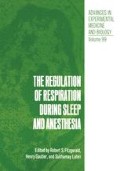Abstract
The effects of anesthetic agents on breathing in man are not well described. In part this reflects the difficulty in obtaining control measurements in awake man, without awareness of the subject that his breathing is being measured. In the present work we report a method for assessing respiratory volume changes in man by measuring body surface displacements. This method has the advantage that since measurements are not made at the mouth, subject awareness (and presumably behavioral alteration) of spontaneous breathing is minimized. An additional advantage of the present work is that continuous measurements of respiratory volume changes can be recorded prior to, during, and subsequent to the induction of general anesthesia. Because of the continuous nature of the measurement we hoped to be able to resolve the controversy concerning changes in functional residual capacity (FRC) and breathing pattern during anesthesia.
Access this chapter
Tax calculation will be finalised at checkout
Purchases are for personal use only
Preview
Unable to display preview. Download preview PDF.
References
Grimby, G., Bunn, J. and Mead, J.: Relative contribution of rib cage abdomen to ventilation during exercise. J. App1. Physio1. 24:159–165, 1968.
Konno, K. and Mead, J.: Measurement of the separate volume changes in rib cage and abdomen during breathing. J. App1. Physio1. 22:407–422, 1967.
Mead, J., Peterson, N., Grimby, G. and Mead, J.: Pulmonary ventilation measured from body surface movements. Science 196:1383–1384, 1967.
Stagg, D., Goldman, M. and Newsom-Davis, J.: Computer aided measurement of breath volume and time components using magnetometers. J. App1. Physio1. (in press).
Goldman, M.D. and Mead, J.: Mechanical interaction between the diaphragm and rib cage. J. App1. Physio1. 35:197–204, 1973.
Agostoni, E., Mognoni, P., Torri, G. and Saracino, F.: Relation between changes of rib cage circumference and lung volume. J. App1. Physio1. 20:1179–1186, 1965.
Author information
Authors and Affiliations
Editor information
Editors and Affiliations
Rights and permissions
Copyright information
© 1978 Plenum Press, New York
About this chapter
Cite this chapter
Goldman, M.D., Morris, T.H., Kendall, L.G., Loh, L. (1978). The Effects of Fentanyl and Thiopental on Breathing in Man. In: Fitzgerald, R.S., Gautier, H., Lahiri, S. (eds) The Regulation of Respiration During Sleep and Anesthesia. Advances in Experimental Medicine and Biology, vol 99. Springer, Boston, MA. https://doi.org/10.1007/978-1-4613-4009-6_13
Download citation
DOI: https://doi.org/10.1007/978-1-4613-4009-6_13
Publisher Name: Springer, Boston, MA
Print ISBN: 978-1-4613-4011-9
Online ISBN: 978-1-4613-4009-6
eBook Packages: Springer Book Archive

